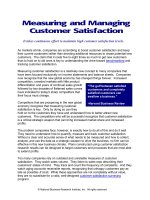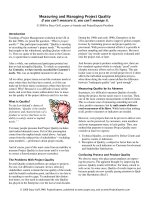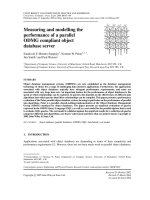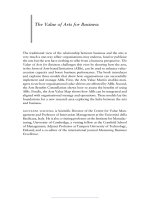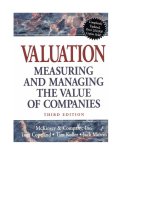valuation measuring and managing the value of companies - 3rd edition
Bạn đang xem bản rút gọn của tài liệu. Xem và tải ngay bản đầy đủ của tài liệu tại đây (16.17 MB, 508 trang )
Page i
Valuation
Measurin
g
and Mana
g
in
g
the Value of Companies
Page ii
WILEY FINANCE
Advanced Fixed-
I
ncome Valuation Tools, Narasimham Je
g
adeesh and Bruce Tuckman
B
e
y
ond Value at Risk, Kevin Dow
d
B
u
y
in
g
and Sellin
g
Volatilit
y
, Kevin B. Connoll
y
Chaos and Order in the Capital Markets: New View of Cycles, Prices, and Market Volatility,
Second Edition, Ed
g
ar E. Peters
Cor
p
orate Financial Distress and Bankru
p
tc
y
, Second Edition, Edward I. Altman
Credit Derivatives: A Guide to Instruments and A
pp
lications, Janet Tavakoli
Credit Risk Measurement: New Approaches to Value at Risk and Other Paradigms, Anthony
Saunders
Currenc
y
Derivatives: Pricin
g
Theor
y
, Exotic O
p
tions, and Hed
g
in
g
A
pp
lications, David F. DeRosa
D
amodaran on Valuation: Anal
y
sis
f
or Investment and Cor
p
orate Finance, Aswath Damodaran
D
erivatives Dem
y
sti
f
ied: Usin
g
Structured Financial Products, John C. Braddoc
k
D
erivatives
f
or Decision-
M
akers: Strate
g
ic Mana
g
ement Issues, Geor
g
e Crawford and Bid
y
ut Sen
Derivatives Handbook: Risk Management and Control, Robert J. Schwartz and Clifford W. Smith,
Jr.
D
erivatives: The Theor
y
and Practice o
f
Financial En
g
ineerin
g
, Paul Wilmott
D
ictionar
y
o
f
Financial En
g
ineerin
g
, John F. Marshall
Dy
namic Hed
g
in
g
: Mana
g
in
g
Vanilla and Exotic O
p
tions, Nassim Taleb
The E
q
uit
y
-
R
isk Premium: Lon
g
-
R
un Future o
f
the Stock Market, Bradford Cornell
F
inancial Statement Anal
y
sis: A Practitioner's Guide, Second Edition, Martin S. Fridson
F
ixed Income Securities: Tools
f
or Toda
y
's Markets, Bruce Tuckman
F
ixed-
I
ncome Anal
y
sis
f
or the Global Financial Market, Gior
g
io Questa
The Forei
g
n Exchan
g
e and Mone
y
Markets, Second Edition, Julian Walmsle
y
Global Trade Financin
g
, Harr
y
M. Venedikian and Gerald A. Warfiel
d
The Handbook of Equity Derivatives, Revised Edition, Jack Francis, William Toy, and J. Gregg
Whittake
r
The Inde
p
endent Fiduciar
y
: Investin
g
f
or Pension Funds and Endowment Funds, Russell L. Olson
I
nterest-
R
ate O
p
tion Models, Ricardo Rebonato
International M&A, Joint Ventures, and Beyond: Doing the Deal, David J. BenDaniel and Arthur
Rosenbloom
Investing in Africa: An Insider's Guide to the Ultimate Emerging Market, Justin Beckett and
Michael Sudarkasa
I
nvestment Mana
g
ement, Peter L. Bernstein and Aswath Damodaran
I
nvestment Timin
g
and the Business C
y
cle, Jon G. Ta
y
lo
r
I
nvestment Valuation, Aswath Damodaran
M
&A: A Practical Guide to Doin
g
the Deal, Jeffre
y
C. Hooke
Managing Credit Risk: The Next Great Financial Challenge, John Caouette, Edward Altman, and
Paul Nara
y
anan
M
ana
g
in
g
Derivative Risks: The Use and Abuse o
f
Levera
g
e, Lilian Chew
M
easurin
g
Market Risk with Value at Risk, Pietro Penza and Vi
p
ul K. Bansal
New Dimensions in Investor Relations, Bruce Marcus and Sherwood Wallace
New Financial Instruments: Investor's Guide, Julian Walmsle
y
O
p
tion Pricin
g
Models, Les Clewlow and Chris Stricklan
d
O
p
tions on Forei
g
n Exchan
g
e, Second Edition, David F. DeRosa
O
p
tions, Futures, and Exotic Derivatives: Theor
y
, A
pp
lication & Practice, Eric Bri
y
s
Pension Fund Excellence: Creating Value for Stockholders, Keith P. Ambachtsheer and D. Don
Ezra
P
ort
f
olio Indexin
g
: Theor
y
and Practice, Harold Hutchinson
P
ricin
g
Financial Instruments: The Finite Di
ff
erence Method, Domin
g
o Tavella and Curt Randall
P
ro
j
ect Financin
g
: Asset-
B
ased Financial En
g
ineerin
g
, John D. Finnert
y
Relative Dividend Yield: Common Stock Investing for Income and Appreciation, Second Edition,
Anthon
y
E. S
p
are
R
isk Arbitra
g
e: An Investor's Guide, Keith M. Moore
R
isk Mana
g
ement: A
pp
roaches
f
or Fixed Income Markets, Bennett W. Golub and Leo M. Tilman
Security Analysis on Wall Street: A Comprehensive Guide to Today's Valuation Methods, Jeffrey C.
Hooke
St
y
le Investin
g
: Uni
q
ue Insi
g
ht into E
q
uit
y
Mana
g
ement, Richard Bernstein
Usin
g
Economic Indicators to Im
p
rove Investment Anal
y
sis, Second Edition, Evelina Taine
r
Valuation: Measuring and Managing the Value of Companies, McKinsey & Company, Inc., Tom
Co
p
eland, Tim Koller, and Jack Murrin
Value Investin
g
: A Balanced A
pp
roach, Martin J. Whitman
Page iii
Valuation
Measurin
g
and Mana
g
in
g
the Value of Companies
Third Edition
McKinsey & Company, Inc.
Tom Copeland
Tim Koller
Jack Murrin
Page iv
D
isclaimer:
This netLibrary eBook does not include the ancillary media that was packaged with the original
p
rinted version of the book.
Co
py
ri
g
ht © 1990, 1994, 2000 b
y
McKinse
y
& Com
p
an
y
, Inc. All ri
g
hts reserved.
Published b
y
John Wile
y
& Sons, Inc.
N
o part of this publication may be reproduced, stored in a retrieval system or transmitted in any
form or by any means, electronic, mechanical, photocopying, recording, scanning or otherwise,
except as permitted under Section 107 or 108 of the 1976 United States Copyright Act, without
either the prior written permission of the Publisher, or authorization through payment of the
appropriate per-copy fee to the Copyright Clearance Center, 222 Rosewood Drive, Danvers, MA
01923, (978) 750-8400, fax (978) 750-4744. Requests to the Publisher for permission should be
addressed to the Permissions Department, John Wiley & Sons, Inc., 605 Third Avenue, New York,
N
Y 10158-0012,
(
212
)
850-6011, fax
(
212
)
850-6008, E-Mail: PERMREQ
@
WILEY.COM.
This publication is designed to provide accurate and authoritative information in regard to the
subject matter covered. It is sold with the understanding that the publisher is not engaged in
rendering professional services. If professional advice or other expert assistance is required, the
services of a com
p
etent
p
rofessional
p
erson should be sou
g
ht.
This title is also available in
p
rint as ISBN 0-471-36190-9
(
cloth
)
For more information about Wile
y
p
roducts, visit our web site at www.Wile
y
.com
Page v
ABOUT THE AUTHORS
The authors are all current or former partners of McKinsey & Co., Inc., and co-leaders of its
corporate finance practice. Collectively, they have served more than 400 companies in 40 countries
on cor
p
orate strate
gy
, mer
g
ers and ac
q
uisitions, and value-
b
ased mana
g
ement.
McKinsey, & Company, Inc.,
is an international top management consulting firm. Founded in
1926, McKinsey advises leading companies around the world on issues of strategy, organization,
and operations, and in specialized areas such as finance, information technology and the Internet,
research and develo
p
ment, sales, marketin
g
, manufacturin
g
, and distribution.
Tom Copeland,
a former partner of McKinsey & Co., was co-leader of the firm's corporate finance
practice. Before joining McKinsey, he was a professor of finance at UCLA's Anderson Graduate
School of Management. He was also an adjunct professor at New York University and is currently
senior lecturer at the Massachusetts Institute of Technology. Tom is co-author of two leading
textbooks, Financial Theory and Corporate Policy and Managerial Finance. He is currently leader
of a corporate finance practice. He received his PhD from the University of Pennsylvania and his
MBA from Wharton.
Tim Koller
is a partner at McKinsey & Co. and has been a co-leader of the firm's corporate finance
practices in both the United States and Europe. He was formerly a vice president at Stern Stewart &
Co., a financial consultin
g
firm. He received his MBA from the Universit
y
of Chica
g
o.
Jack Murrin
co-founded and co-led McKinsey's corporate finance practice, serving as a partner in
the firm's New York and London offices. He has subsequently held senior strategic and financial
positions at leading companies, most recently as senior managing director and head of corporate
development at Bankers Trust Corp. Jack, a certified public accountant, holds an MBA from
Stanford Business School.
Page vii
PREFACE
The first edition of this book was published in 1990, yet it continues to attract readers around the
world. We believe that the book has succeeded because it is grounded in universal economic
principles. While we continue to improve and update the text as our experience grows, the
fundamental
p
rinci
p
les do not chan
g
e. The
y
are valid across time and
g
eo
g
ra
p
h
y
.
Our message is simple: Companies thrive when they create real economic value for their
shareholders. Companies create value by investing capital at rates of return that exceed their cost of
capital. This applies equally to U.S., European, and Asian companies. It applies equally to mature
manufacturing companies and high-growth Internet companies. Only the implementation details are
different.
When companies forget these simple truths, consequences are evident: hostile takeovers in the
United States in the 1980s, the collapse of the bubble economy in Japan in the 1990s, the broad
Southeast Asian crisis in 1998, and the persistent slow growth and high unemployment in Europe.
While the underlying drivers of these events can be traced to a number of factors—most often
inappropriate government policies or structural deficiencies—the lack of focus on value creation by
mana
g
ers is a ke
y
link in the chain leadin
g
to economic malaise or crisis.
We wrote this book for managers (and future managers) who want their companies to create value.
It is a how-to book. We hope that it is a book that you will use again and again. If we have done our
j
ob well, it will soon be transformed with underlining, margin notations, and highlighting. This is no
coffee-table book.
The Need to Mana
g
e Value
In the last two decades, two kinds of thinking and activity—corporate finance and corporate
strate
gy
—have come to
g
ether with a resoundin
g
crash.
Page viii
Corporate finance is no longer the exclusive preserve of financiers. Corporate strategy is no longer a
separate realm ruled by CEOs. Participants in the financial markets are increasingly involved in
business operations through leveraged buyouts, hostile takeovers, and proxy contests. At the same
time, chief executives have led their companies to become increasingly active players in the
financial markets through mergers and acquisitions, restructurings, leveraged buyouts, share
repurchases, and the like. Financing and investment are now inextricably connected. In the Internet
world, for example, having a high share value is essential for making acquisitions and attracting
talent.
This new reality presents a challenge to business managers: the need to manage value and to focus
as never before on the value their corporate and business-level strategies are creating. In the quest
for value, they find that they must consider such radical alternatives as selling the ''crown jewels" or
completely restructuring operations. And they need more systematic and reliable ways to look for
opportunities in the turbulence resulting from the confluence of strategy and finance. As a result of
restructuring, for instance, companies create new opportunities to acquire assets and businesses that
ma
y
be worth more to them than to their ori
g
inal owners.
Why This Boo
k
This book began life as a handbook for McKinsey consultants. This beginning is reflected in the
nature of the book. While the book draws on leading edge academic thinking, its purpose is practical
application. It aims to demystify the field of valuation and to clarify the linkages between strategy
and finance.
We believe that clear thinking about valuation and skill in using valuation to guide business
decisions are prerequisites for success in today's competitive environment. Value needs to be
understood clearly by CEOs, business managers, and financial managers alike. Too often, valuation
has been left to experts. It has been viewed as a specialized discipline, rather than as an important
tool for runnin
g
the business better.
In this book, we hope to lift the veil on valuation by explaining, step-by-step, how to do it well. We
spell out valuation frameworks that we use in our consulting work, and we bring these frameworks
to life with detailed case studies that highlight the practical judgments involved in developing and
using valuations. Most significantly, we discuss how to use valuation to make decisions about
courses of action for a com
p
an
y
.
This book can be used b
y
a wide audience, includin
g
:
• Business managers. Now more than ever, leaders at the corporate and business-unit levels need to
know how to assess the value o
f
Page ix
alternative strategies. They need to know how much value they can create through restructuring and
other major transactions. Beyond this, they need to instill a managing-value mindset throughout
their or
g
anizations.
• Corporate finance practitioners. Valuation approaches and the linkage between finance and
strategy are important to chief financial officers, merger and acquisition specialists, corporate
financial professionals, and corporate development managers and strategists. Value—how to assess
it, create it, and communicate it—lies at the core of their roles and res
p
onsibilities.
• Investors, portfolio managers, and securities analysts. These professionals should find this volume
a useful guide to applying cash flow valuation approaches. This is the purest form of fundamental
securities analysis, since it links the value of the company directly to the economic returns it can
g
enerate from its businesses and assets.
When to Use It
First and foremost, this book is written for those who want to improve their ability to create value
for the stakeholders in their business. It will be of most use when
y
ou need to do the followin
g
:
• Estimate the value of alternative corporate and business strategies and the value of specific
programs within those strategies. These strategies include such initiatives as new product
introductions, ca
p
ital ex
p
enditures, and
j
oint venture a
g
reements.
• Assess major transactions such as mergers, acquisitions, divestitures, recapitalizations, and share
re
p
urchases.
• Use value-based management to review and target the performance of business operations. It is
essential to know whether and to what extent a business—as currently performing and configured—
is creating value. Equally important is the need to understand which operating drivers have the
g
reatest
p
ros
p
ects for enhancin
g
value.
• Communicate with key stakeholders, especially stockholders, about the value of the business. Our
fundamental premise is that the value of a company derives from its ability to generate cash flows
and cash-flow-based returns on investment. Many companies could do a much better job than they
now do of communicating with the market and other players about the value of their plans and
strategies. But first they need to become value managers themselves, and to understand what value
the
y
are creatin
g
and wh
y
.
Page x
Intellectual Foundations
One of us was asked by the editor of Le Figaro in Paris, ''What is new about your approach?" As far
as the methodology is concerned, the answer is practically nothing. Valuation is an age-old
methodology in finance with its intellectual origins in the present value method of capital budgeting
and in the valuation approach developed by Professors Merton Miller and Franco Modigliani, both
N
obel laureates, in their 1961 Journal of Business article entitled "Dividend Policy, Growth and the
Valuation of Shares." Our intellectual debt is primarily to them, but others have gone far to
popularize their approach. In particular, Professor Alfred Rappaport of Northwestern University (co-
founder of ALCAR) and Joel Stern (of Stern Stewart & Co.) were among the first to extend the
Miller-Modigliani entity valuation formula to real-world applications and to develop and market
com
p
uter tools for makin
g
this an eas
y
task for com
p
anies.
Structure of the Boo
k
The book is organized into three parts. Part One provides a managerial perspective on valuation and
managing shareholder value. Part Two is a step-by-step approach to valuing a company. Part Three
deals with more com
p
lex valuation issues and s
p
ecial cases.
In Part One, we discuss the link between business strategies and value. In Chapter 1, we make the
case that managing shareholder value is a central role and challenge for senior managers. In Chapter
2, we develop a picture of what it means to be a value manager. We do this through a detailed case
study based on the actual experiences of a CEO who needed to restructure his company and build a
new managing-value philosophy throughout it. Chapter 3 summarizes the basic principles of value
creation through a simple case example, focusing on the intuition behind the approach, not the
mathematics. Chapter 4 attempts to sort through the confusing jargon about various metrics that you
will come across by providing a simple, yet comprehensive framework. Chapter 5 provides the
empirical evidence supporting our discounted cash flow view of valuation. Chapter 6 describes the
softer aspects of implementing value management. Finally, Chapter 7 provides an overview of value
creation in the context of mer
g
ers, ac
q
uisitions, and alliances.
Part Two—Chapters 8 through 13—is a self-contained handbook for doing valuations of single-
business companies. In it we describe a general approach to discounted cash flow valuations and
how to implement it. This includes how to analyze historical performance, forecast free cash flows,
estimate the appropriate opportunity cost of capital, identify sources of value, and interpret results.
As a further aid to the
p
ractitioner, we walk throu
g
h
Page xi
the valuation of a com
p
an
y
(
Heineken
)
from the outside, usin
g
p
ublicl
y
available information.
Part Three—Chapters 14 through 22—is devoted to valuation in more complex situations. We have
included chapters on valuing high growth Internet companies, multibusiness companies, cyclical
companies, banks, and insurance companies. Three chapters deal with issues related to valuation
outside the United States: valuing foreign subsidiaries, valuing companies outside the United States,
and valuing companies in emerging markets. Finally, we explore the application of option pricing
theor
y
to assets, liabilities, and investment decisions.
What's New about the Third Edition
In the 10 years between the first and third editions, we have gained experience applying valuation in
our consulting work and have received considerable feedback from readers. Building on these
experiences, we have extensively rewritten and updated core chapters, adding more detail on
practical issues that managers and analysts face. We have updated most of the examples and
empirical analysis. We have also added six new chapters. Entirely new chapters have been added on
valuing Internet companies, valuing cyclical companies, and valuing insurance companies. Valuing
companies in emerging markets now warrants its own chapter. Finally, we have created two
chapters early in the book, one that provides a nonmathematical, intuitive overview of the principles
of value creation, and one that provides an overarching framework for cutting through the confusion
of mana
g
ement
p
erformance metrics.
Valuation Spreadsheet
An Excel spreadsheet valuation model is available on CD-ROM. This valuation model is similar to
the model we use in practice. Practitioners will find the model easy to use in a variety of situations:
mergers and acquisitions, valuing business units for restructuring or value-based management, or
testing the implications of major strategic decisions on the value of your company. We accept no
responsibility for any decisions based on your inputs to the model. If you would like to purchase the
spreadsheet, ISBN 0-471-39749-0, please call 1-800-225-5945 or visit www.WileyValuation.com
to
p
urchase the model via web download.
TOM COPELAND
TIM KOLLER
JACK MURRIN
Page xi
the valuation of a com
p
an
y
(
Heineken
)
from the outside, usin
g
p
ublicl
y
available information.
Part Three—Chapters 14 through 22—is devoted to valuation in more complex situations. We have
included chapters on valuing high growth Internet companies, multibusiness companies, cyclical
companies, banks, and insurance companies. Three chapters deal with issues related to valuation
outside the United States: valuing foreign subsidiaries, valuing companies outside the United States,
and valuing companies in emerging markets. Finally, we explore the application of option pricing
theor
y
to assets, liabilities, and investment decisions.
What's New about the Third Edition
In the 10 years between the first and third editions, we have gained experience applying valuation in
our consulting work and have received considerable feedback from readers. Building on these
experiences, we have extensively rewritten and updated core chapters, adding more detail on
practical issues that managers and analysts face. We have updated most of the examples and
empirical analysis. We have also added six new chapters. Entirely new chapters have been added on
valuing Internet companies, valuing cyclical companies, and valuing insurance companies. Valuing
companies in emerging markets now warrants its own chapter. Finally, we have created two
chapters early in the book, one that provides a nonmathematical, intuitive overview of the principles
of value creation, and one that provides an overarching framework for cutting through the confusion
of mana
g
ement
p
erformance metrics.
Valuation Spreadsheet
An Excel spreadsheet valuation model is available on CD-ROM. This valuation model is similar to
the model we use in practice. Practitioners will find the model easy to use in a variety of situations:
mergers and acquisitions, valuing business units for restructuring or value-based management, or
testing the implications of major strategic decisions on the value of your company. We accept no
responsibility for any decisions based on your inputs to the model. If you would like to purchase the
spreadsheet, ISBN 0-471-39749-0, please call 1-800-225-5945 or visit www.WileyValuation.com
to
p
urchase the model via web download.
TOM COPELAND
TIM KOLLER
JACK MURRIN
Page xiii
ACKNOWLEDGMENTS
N
o book is solely the effort of its authors. This book is certainly no exception, especially since it
grew out of the collective work of McKinsey's corporate finance practice and the experiences of
consultants throu
g
hout the world.
First, we would like to thank Ennius Bergsma. Ennius initiated the development of McKinsey's
corporate finance practice in the mid-1980s and was instrumental in bringing the three authors
together. He encouraged us to turn our original internal McKinsey valuation handbook into a real
book for an external audience. He mustered the internal support and sponsorship that we needed to
make this happen. Ennius has always been a key discussion partner for us. He also co-wrote Chapter
1, Wh
y
Value Value?
Fred Gluck deserves our special thanks. Fred played a vital role in creating a knowledge building
culture within McKinsey. As the firm's Managing Director, he was like a godfather to many of us
and our colleagues. Fred was a vocal supporter of creating a strong corporate financial advisory
p
ractice at McKinse
y
.
For the third edition, we would like to thank several people who worked closely with us on key
chapters. David Krieger prepared the analysis and valuation of Heineken that appears throughout the
book. Susan Nolen contributed to Chapter 6, Making Value Happen, drawing from an internal
project she was leading. Mimi James guided us through the complexities of valuing companies in
emerging market countries in Chapter 19. Alice Hu brought us into the Internet world, helping us
write Chapter 15, Valuing Dot.coms. Marco de Heer's thesis on valuing cyclical companies formed
the basis for Chapter 16. Vladimir Antikarov and Phil Keenan were steadfast thought partners for
the option pricing work in Chapter 20. Gabriel Garcia and Mimi James were instrumental in
developing Chapter 22 on valuing insurance companies. Valerie Udale and Annemarie van Neck
u
p
dated the Excel valuation model, makin
g
it easier to navi
g
ate and more flexible.
Page xiv
Alice Hu, Irina Grigorenko, Kim Vogel, David Twiddy, Chris Jones, David Wright, and Sandeep
Vaswani provided analytical support and number crunching for the third edition. We would also like
to thank Petri Allas, André Annema, Olivier Berlage, Richard Dobbs, George Fenn, Marc Goedhart,
Kevin Kaiser, and Pieter de Wit for ideas, formulas, and debates.
We would like to reiterate our thanks to all those who contributed to the first two editions. We owe
a special debt to Dave Furer for help and late nights developing the original drafts of this book more
than 10 years ago. The first two editions and this edition drew on work, ideas, and analyses from
Carlos Abad, Buford Alexander, Pat Anslinger, Ali Asghar, Bill Barnett, Dan Bergman, Peter
Bisson, the late Joel Bleeke, Steve Coley, Johan Depraetere, Mikel Dodd, Will Draper, Christian
von Drathen, David Ernst, Bill Fallon, Russ Fradin, Alo Ghosh, Keiko Honda, Phil Kholos,
Shyanjaw Kuo, Kurt Losert, Bill Lewis, Perry Moilinoff, Mike Murray, Juan Ocampo, John
Patience, Bill Pursche, Frank Richter, David Rothschild, Silvia Stefini, Konrad Stiglbrunner, Ahme
d
Taha, Bill Trent, Jon Weiner, Jack Welch, and David Willensk
y
.
For help in preparing the manuscript and coordinating the flow of paper, e-mails and phone calls
between four countries and seven time zones, we owe our thanks to our assistants, Marlies Zwaan
and Betsy Bellingrath. Geoff Andersen designed the updated and attractive exhibits that accompany
the text.
Allan Gold edited the manuscript and kept reminding us that we were writing for the reader, not for
ourselves. Allan was also a great sounding board for weary authors. Nancy Nichols also contributed
to the editin
g
of the book.
The University edition of this book includes end-of-chapter questions and an instructor's resource
guide based on material in this book. Additionally, a professional workbook accompanies this book.
We would like to thank Bill Foote for preparing the pedagogy for the University edition and for
creating the Valuation Workbook. This workbook is an important complement to the text for
p
ractitioners and students alike.
We couldn't have devoted the time and energy to this book without the support and encouragement
of McKinsey's corporate finance and strategy practice leadership, in particular Christian Caspar and
Ron Hulme. We also thank Alan Kantrow for his sa
g
e counsel.
Thank you as well to our editors at Wiley, Pamela van Giessen and Claudio Campuzano, and to
N
ancy Marcus Land and her staff at Publications Development Company for copyediting and
p
roduction.
Finally, thank you to Maggie Copeland, Melissa Koller, and Wendy Murdock, our most important
supporters. This book truly would not have been possible without your encouragement and
understandin
g
.
T. C.
T. K.
J. M.
Page xv
CONTENTS
Part One
Company Value and the Mana
g
er's Mission
1
Wh
y
Value Value?
3
2
The Value Mana
g
e
r
17
3
Fundamental Princi
p
les of Value Creation
47
4
Metrics Mania: Survivin
g
the Barra
g
e of Value Metrics
55
5
Cash Is Kin
g
73
6
Makin
g
Value Ha
pp
en
89
7
Mer
g
ers, Ac
q
uisitions, and Joint Ventures
111
Part Two
Cash Flow Valuation: A Practitioner's Guide
8
Frameworks for Valuation
131
9
Anal
y
zin
g
Historical Performance
157
10
Estimatin
g
the Cost of Ca
p
ital
201
11
Forecastin
g
Performance
233
12
Estimatin
g
Continuin
g
Value
267
13
289
Calculatin
g
and Inter
p
retin
g
the Results
Part Three
Applyin
g
Valuation
14
Multibusiness Valuation
301
15
Valuin
g
Dot.coms
315
16
Valuin
g
C
y
clical Com
p
anies
327
17
Valuin
g
Forei
g
n Subsidiaries
335
Page xvi
18
Valuation Outside the United States
353
19
Valuation in Emer
g
in
g
Markets
373
20
Usin
g
O
p
tion Pricin
g
Methods to Value Flexibilit
y
395
21
Valuin
g
Banks
427
22
Valuin
g
Insurance Com
p
anies
449
Appendix A
More On the Ad
j
usted Present Value Model
471
Index
479
Page 1
PART ONE—
COMPANY VALUE AND THE MANAGER'S MISSION
Page 3
1—
Why Value Value?
This book is about how to value companies and use information about valuation to make wiser
business decisions. Underlying it is our basic belief that managers who focus on building
shareholder value will create healthier companies than those who do not. We also think that
healthier companies will, in turn, lead to stronger economies, higher living standards, and more
career and business o
pp
ortunities for individuals.
There has always been, and continues to be, vigorous debate on the importance of shareholder value
relative to other measures such as employment, social responsibility, and the environment. The
debate is often cast in terms of shareholder versus stakeholder. At least in ideology and legal
frameworks, the United States and the United Kingdom have given the most weight to the idea that
shareholders are the owners of the corporation, the board of directors is their representative and
elected b
y
them, and the ob
j
ective function of the cor
p
oration is to maximize shareholder value.
In continental Europe, an explicitly broader view of the objectives of business organizations has
long been more influential. In many cases, it has been incorporated into the governance structures of
the corporation form of organization. Under Dutch law, for example, the board of a Structural
N
.V.—effectively a large corporation—is mandated to ensure the continuity of the business, not to
represent shareholders in the pursuit of value maximization. Similar philosophies lay at the
foundation of cor
p
orate
g
overnance in German
y
and Scandinavia.
Our principal aim in this book is not to analyze, resolve, or even stoke the debate between
shareholder and stakeholder models. However, we believe managers should focus on value creation
for two reasons. First, in most developed countries, shareholder influence already dominates the
a
g
enda
Our thanks to Ennius Bergsma, who co-wrote this chapter.
Page 4
of top management. Second, shareholder-oriented economies appear to perform better than other
economic s
y
stems and other stakeholders do not suffer at the hands of shareholders.
Ascendancy of Shareholder Value
Early in 2000, Vodafone AirTouch acquired the German conglomerate Mannesmann, the first major
hostile takeover of a German company by a non-German company.
1
This event signaled the
broadening acceptance of the shareholder value model in Europe. It might now be argued that
managers in most of the developed world must focus on building shareholder value. Four major
factors have
p
la
y
ed a role in the ascendanc
y
of shareholder value:
1. The emergence of an active market for corporate control in the 1980s, following the apparent
inabilit
y
of man
y
mana
g
ement teams to res
p
ond effectivel
y
to ma
j
or chan
g
es in their industries.
2. The growing importance of equity-based features in the pay packages of most senior executives
in the United States and man
y
in Euro
p
e as well.
3. The increased penetration of equity holdings as a percentage of household assets, following the
stron
g
p
erformance of the U.S. and Euro
p
ean e
q
uit
y
markets since 1982.
4. The growing recognition that many social security systems, especially in continental Europe and
Ja
p
an, are headin
g
for insolvenc
y
.
The Market
f
or Corporate Control
In 1982, the U.S. economy started to recover from a prolonged period of high inflation and low
economic growth. Many industrial sectors required major restructuring. For example, the invention
of the radial tire had more than doubled the effective life of tires, leading to huge overcapacity.
Rather than eliminating excess capacity and taking cash out of the business, most major tire
manufacturers continued investing heavily, setting themselves up for a rude awakening later in the
decade.
At the same time, pension funds and insurance companies began to provide increasingly large pools
of funds to new kinds of investors, principally leveraged buyout (LBO) groups such as Kohlberg,
Kravis, and Roberts (KKR) and Clayton, Dubilier, and Rice. In 1981, of 2,328 mergers and
ac
q
uisitions in
1
Technically, Mannesmann agreed to a negotiated transaction, but only when it was clear that the shareholders
would vote in favor of Vodafone AirTouch.
Page 5
the United States, 99 were in the form of leveraged buyouts.
2
By 1988, this number had climbed to
381, of a total of 4,049. Probably more important than the hard numbers was the perception of what
was happening in the marketplace. The size of the leveraged buyouts had become huge, with the
RJR-Nabisco transaction topping the charts at $31.4 billion. This was only four years after the first
leveraged buyout exceeding $1 billion, KKR's purchase of the conglomerate Wometco in 1984.
While many leveraged buyouts were friendly, the vehicle lent itself to hostile acquisitions as well.
Indeed, the most visible hostile transactions in the late 1980s were LBOs, of which RJR-Nabisco
was a leadin
g
exam
p
le.
The structure of a leveraged buyout, combined with the emergence of high-yield bonds as a major
funding instrument, put much of corporate America within range of hostile takeovers. Not
surprisingly, companies that were not dealing effectively with major changes in their industry
became targets. In the tire industry, BF Goodrich and UniRoyal were restructured on a friendly
b
asis, but Good
y
ear and GenCor
p
(
the owners of General Tire
)
came under attack.
This emergence of the market for corporate control provoked a backlash from established
enterprises and their executives. By 1984, the Business Roundtable, an organization that represents
the largest corporations in the United States, had already issued a working paper that supported the
stakeholder view of corporate governance, largely echoing the prevalent point of view in Europe.
By the end of the decade, an increasingly large and vocal opposition to the market for corporate
control—as embodied by highly leveraged and hostile transactions—led to its curtailment, but only
tem
p
oraril
y
.
By the end of the 1990s, the buyout market was again hot, except this time most of the deals were
friendly. Managers had learned the lessons of shareholder value and weren't waiting for hostile
bidders. At the same time, the LBO had moved to Europe. Many European buyout groups were
formed and American firms be
g
an to look for deals in Euro
p
e as well.
How do LBOs create value? The argument runs along these lines: Many mature, established
industries that have been subject to hostile takeovers generate high levels of free cash flow. Some
companies in this situation, such as those in the tire, oil and gas, and consumer packaged goods
industries, often do not have sufficient attractive investment opportunities. Nevertheless, the natural
inclination of an enterprise is to reinvest its cash, rather than give it back to shareholders. Such an
approach can result in bad investments that reduce shareholder value. The poor investments take
these forms: Money is invested in businesses that the company knows, but are not attractive, or in
b
usinesses it does not know and is unlikel
y
to succeed in.
2
G. Baker and G. Smith, The New Financial Capitalists: Kohlberg Kravis Roberts and the Creation of
Corporate Value (Cambridge, England: Cambridge University Press, 1998).
Page 6
Outside intervention is an instrument through which this economically suboptimal allocation of cash
resources can be stopped. In the case of an LBO, this occurs through substituting equity with debt,
forcing much of the free cash flow out of the enterprise and back into the capital markets in the form
of interest and principal payments. This need not be done through outside intervention; it can also be
accomplished voluntarily through a leveraged recapitalization, where a company takes on debt and
uses the
p
roceeds to re
p
urchase a lar
g
e
p
ro
p
ortion of its own e
q
uit
y
.
What both situations have in common, though, is that they usually lead to significant increases in
value accruing to existing shareholders. Indeed, if the corporate objective is shareholder value
maximization, spending on unattractive investments is much more likely to be curtailed than if
mana
g
ers are followin
g
some other ob
j
ective, such as em
p
lo
y
ment
p
reservation.
To summarize, the restructuring movement of the 1980s was a reaction to the inability of many
corporations to adjust and change direction as their traditional product and market opportunities
matured or became otherwise unattractive. The instrument through which much of this restructuring
took place was the market for corporate control. The basic premise of the market for corporate
control is that managers have the right to manage the corporation as long as its market value cannot
b
e significantly enhanced by an alternate group of managers with an alternate strategy. Accordingly,
the ke
y
driver for chan
g
e was the
p
oor
p
erformance of a com
p
an
y
in terms of shareholder value.
The Increased Role o
f
Stock Options
In the mid-1970s in the United States, there was growing concern about the perceived divergence
between managers' and shareholders' interest. In part, this feeling reflected anxiousness over 10
years of falling corporate profitability and stagnant share prices. The concern was also fueled by the
increasing attention paid to stakeholder model arguments, which, in the eyes of shareholder value
proponents, had become an excuse for inadequate performance. Meanwhile, a number of academics
became interested in management's motivation in decisions relating to the allocation of resources, a
branch of research known as agency theory. In 1976, Jensen and Meckling published a paper,
''Theory of the Firm: Managerial Behavior, Agency Costs, and Ownership Structure."
3
They laid out
how over the previous decades corporate management had pursued strategies and projects that were
not likel
y
to o
p
timize resources from a shareholder's
p
ers
p
ective
3
M. Jensen and W. Meckling, "Theory of the Firm: Managerial Behavior, Agency Costs, and Ownership
Structure,"
J
ournal of Financial Economics (October 1976), pp. 305–360.
Page 7
and called for redesigning management's incentives to be more closely aligned with the interests of the shareholders. Stock options had been a
component of the pay packages of most senior executives in the United States, but the size of option grants coupled with the anemic performance of the
stock market as a result of hi
g
h inflation, effectivel
y
made them weak motivators of mana
g
erial behavior.
The situation changed in the early 1980s. The emergence of the LBO, and especially the management buyout, created instances where both the
performance of the company in shareholder value terms and the pay packages accruing to executives as a result of their equity holdings became very
large and noted by the public. At about the same time, in 1982, the U.S. Federal Reserve Board embarked on a program that drastically reduced
inflation, which in turn prompted a sustained rise in equity values. As a result of this confluence of factors, the role of stock options in executive pay
soared. As illustrated in Exhibit 1.1, by 1998, the estimated present value of stock options represented 45 percent of the median pay package for chief
executive officers of
p
ublic cor
p
orations.
Over the same period, boards of directors had come under increased criticism for perceived negligence in representing shareholder interests (which, at
least under the legal requirements in the United States, they were supposed to do). A movement developed to require that nonexecutive board members
have an equity stake in the companies they represented so that they would be more inclined to pay attention to shareholder returns, if only for self-
interest. B
y
the late 1990s, 48
p
ercent of medium and lar
g
e
Exhibit 1.1 Elements of Median CEO Pay Package in USA
1
Page 8
com
p
anies had a stock
g
rant or o
p
tion
p
acka
g
e for board members, in contrast to virtuall
y
none in 1983.
The widening use of stock options has greatly increased the importance of shareholder returns in the measurement of managerial performance. Such
developments are not limited to the United States. Stock options and share grants have become important elements of executive pay in England and
France. As the competition for executive talent becomes global, it seems likely that the use of stock options will become more and more popular in
most o
p
en economies.
The Popularization o
f
E
q
uit
y
The remarkable performance of U.S. and European equity markets since the early 1980s not only contributed to the popularization of stock options in
executive pay packages, but also to the increase in stock ownership by households in many countries. This is not to say that many U.S. and non-U.S.
households have become active investors in individual equities. What has happened is that growing segments of the population are becoming
shareholders through mutual funds and retirement programs. Among the most vocal proponents of shareholder value are the managers of major
retirement systems, such as the California Public Employees Retirement System, which has $130 billion in assets under management, a large part of
which is in e
q
uities.
As shown in Exhibit 1.2, equities are by far the largest asset class in which pension funds are invested in the United States and the United Kingdom,
with 58 percent and 76 percent, respectively, in 1996. The difference compared to countries like Germany, with 8 percent, and Italy, with 3 percent, is
q
uite strikin
g
. But the situation in these countries is chan
g
in
g
ra
p
idl
y
, with an increasin
g
p
ro
p
ortion of
p
ension assets movin
g
into e
q
uities.
Exhibit 1.2 Pension Fund Asset Allocations
